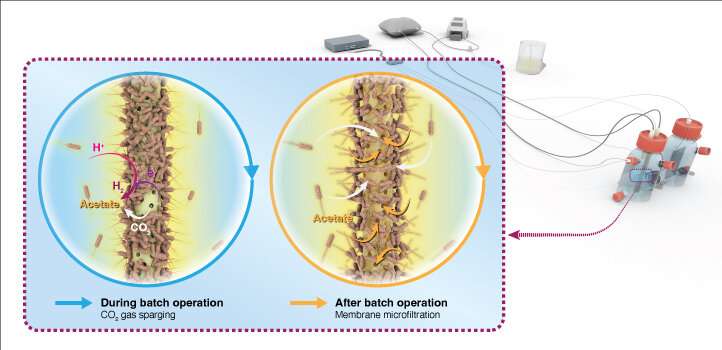Multifunctional porous conductive membranes help microbes eat their way to a faster carbon dioxide conversion

Microporous conductive membranes developed at KAUST are expected to help shape the future of microbial electrosynthesis for CO2 conversion technologies. The membranes simultaneously stimulate the growth of CO2-eating microbes and aid separation of the biochemical products.
Microbial electrosynthesis is a promising strategy to reduce the human carbon footprint. It uses specific living microbes to transform CO2 into useful chemicals in an electrochemical cell via a reduction reaction under applied voltage. With the reduction of CO2, the microbes multiply to form a biofilm on the cathode of the cell, but their growth involves a tedious multistep enrichment process that takes more than 30 days.
This enrichment process is a major bottleneck for achieving industrially attractive biochemical production and CO2 bioconversion. A further drain is the complex and energy intensive techniques deployed to isolate the products, which mainly consist of acetate.
The lead author Bin Bian, a postdoc in Pascal Saikaly’s group, and coworkers had previously used electrochemical bioreactors equipped with conductive hollow fiber membranes to treat wastewater. When doing this, they discovered a thick biofilm formed on the hollow fiber membranes after microfiltration. “This suggested that a similar enrichment process for CO2-eating biofilms could be achieved in microbial electrosynthesis systems,” Bian says.
Inspired by this discovery, the researchers designed metal-coated ceramic hollow fiber membranes to manufacture conducting cathodes that expedite microbial growth while making acetate easier to separate. The coating consisted of uniformly distributed nickel nanoparticles that catalyze the electrolysis of water into hydrogen, a key mediator in the electron transfer between membrane and microbes.
The researchers evaluated the performance of their membrane cathode in abiotic medium and in the presence of sludge. They found that, in both cases, the nickel-catalyzed production of hydrogen was essential in boosting the microbial growth and CO2 conversion into acetate. “Moreover, the hollow fibers served as CO2-delivery channels to the microbes adsorbed on their surface and consequently enhanced the efficiency of the CO2 reduction,” Bian says.
Microbial electrosynthesis systems using the nickel-coated hollow fiber cathodes achieved a stable CO2 bioconversion within one month. “This exceeded our expectations,” says Bian, noting that previous systems required at least three months to reach stable operation. “This is an important aspect for future scale-up,” he explains.
While working on performance improvements, the team is now expanding the reactor volume and treatment capacity of their microbial electrosynthesis system. They are also investigating ways to integrate their system with chain elongation technology to expand the bioconversion to value-added biochemicals other than acetate and methane.
The research was published in Chemical Engineering Journal.
Helpful microbes inhale carbon dioxide through a porous cylindrical electrode and exude useful chemicals
Bin Bian et al, Nickel-Coated ceramic hollow fiber cathode for fast enrichment of chemolithoautotrophs and efficient reduction of CO2 in microbial electrosynthesis, Chemical Engineering Journal (2022). DOI: 10.1016/j.cej.2022.138230
Citation:
Multifunctional porous conductive membranes help microbes eat their way to a faster carbon dioxide conversion (2022, September 20)
retrieved 20 September 2022
from https://phys.org/news/2022-09-multifunctional-porous-membranes-microbes-faster.html
This document is subject to copyright. Apart from any fair dealing for the purpose of private study or research, no
part may be reproduced without the written permission. The content is provided for information purposes only.
For all the latest Science News Click Here
For the latest news and updates, follow us on Google News.

